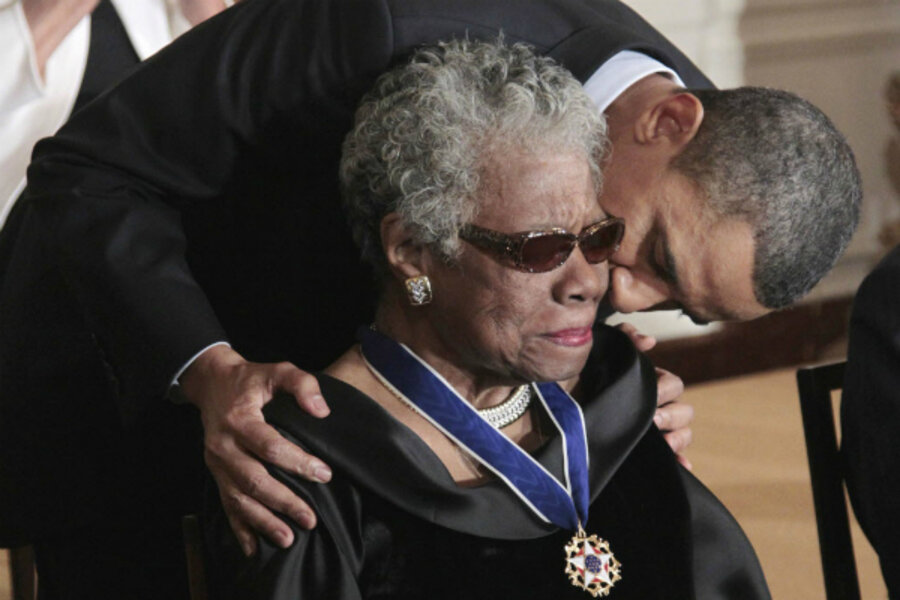Remembering the colossal Maya Angelou: 'But still, like air, I'll rise'
Loading...
Maya Angelou, poet, performer, social activist, and autobiographer, who died on Wednesday, is widely credited with introducing many readers to the experience of being both black and female in the Jim Crow South.
Ms. Angelou was the author of six memoirs, including what is perhaps her most famous work, “I Know Why the Caged Bird Sings” from 1969. Her work amounted to more than 30 titles, including multiple volumes of essays and poems.
She had, indeed, a lot to say – and lived life on a giant scale.
Angelou, who is best known as writer, had also been a newspaper editor in Cairo and an office assistant in Ghana. She had danced and sung – in nightclubs, on television, and on Broadway stages – and she had seen Europe via a traveling road show. In New York, she had partnered with the leaders of the civil rights movement. She had been a cook, a streetcar conductor, and a waitress. She had peeled paint off cars in a mechanic’s workshop. She had been a single mother.
She had called some of America’s most famous figures her friends, and she had received some of its most prestigious honors, including the Presidential Medal of Freedom, the highest civilian honor in the US. She had been written about, and she had written.
She had also been through hard times – born both black and female in an era and in a place in which both identities were targets for injustice and unkindness. But no dart was painful enough to stop her from enjoying her life, and she came through it all bearing for her readers and listeners a message not of hardened resilience, but of stubborn joy.
As she wrote in the poem “I Still Rise” (1978):
Did you want to see me broken?
Bowed head and lowered eyes?
Shoulders falling down like teardrops,
Weakened by my soulful cries?...
You may shoot me with your words,
You may cut me with your eyes,
You may kill me with your hatefulness,
But still, like air, I’ll rise.
Angelou was born Marguerite Ann Johnson on April 4, 1928, in St. Louis, to parents who divorced when she was a toddler. So Angelou, whose brother called her Maya, grew up shuttled between her mother, in St. Louis, and her grandmother, in Stamps, Ark., a small, poor, racially segregated town.
When Angelou was a young child, her mother’s boyfriend raped her. She testified against him, and he was convicted, but a mob murdered him before he could begin his sentence. Angelou, feeling she was to blame for his death, stopped speaking for five years. But when she did find her voice again, it was loud, resonant, and beautiful.
Angelou’s childhood is described in “I Know Why the Caged Bird Sings.” The book, the story of a black woman’s coming of age in a hard place to do so, is widely credited as “the leading edge of a renaissance in literature by black female writers,” as The Washington Post puts it.
For the first time, perhaps, an enormous readership that had never before read, or thought to read, a black woman’s writing came to understand that tellers of great truths are not just white and male. And black and female readers, perhaps sometimes also for the first time, came to understand that their race and gender did not preclude them from living remarkable lives.
In the book, written in her 40s, Angelou also narrates her move with her mother to San Francisco, where she dropped out of dance and drama school at 14 years old to become a cable-car conductor – the city’s first African-American woman to hold that job. She went back to get her diploma and, just weeks after graduation, gave birth to a son. As a teenage single mother, she took up odd jobs to support her child.
Her life after that – up to about age 40, according to The New York Times – is narrated in five subsequent memoirs, written between 1974 and 2002. Together, they tell a story of a woman who, as one longtime reader tells NPR, lived her life “like a banquet,” giddily sampling all its delights, treasures, and opportunities and missing out on nothing.
She was married at least three times – Angelou is a take on her first husband’s last name – though she was vague about the actual number, the Times says. She first used the name Maya Angelou as her stage name while working as a calypso dancer and singer, after her first marriage ended.
Angelou, who never went to college, received more than 50 honorary degrees and was the Reynolds professor of American studies at Wake Forest University in Winston-Salem, N.C. She became a colossal figure (she was also six feet tall) in the American public’s imagination. She reminded people who looked up to her – and many, many did – that “people will forget what you said, people will forget what you did, but people will never forget how you made them feel.”
She also accumulated a massive following on social media, where she dispensed 140-character doses of wisdom as lovely and lyrical as petite poems: “This a wonderful day. I've never seen this one before,” she once tweeted. After her death, Twitter users shared stories of what she had meant to them under the hashtag #MayaTaughtMe.
In January 1993, she read the inaugural poem “On the Pulse of Morning” at Bill Clinton’s swearing-in as the 42nd president of the United States. Her poem, original for the occasion, was broadcast around the world. She said:
History, despite its wrenching pain
Cannot be unlived, but if faced
With courage, need not be lived again.
Lift up your eyes upon
This day breaking for you.
Give birth again
To the dream.






